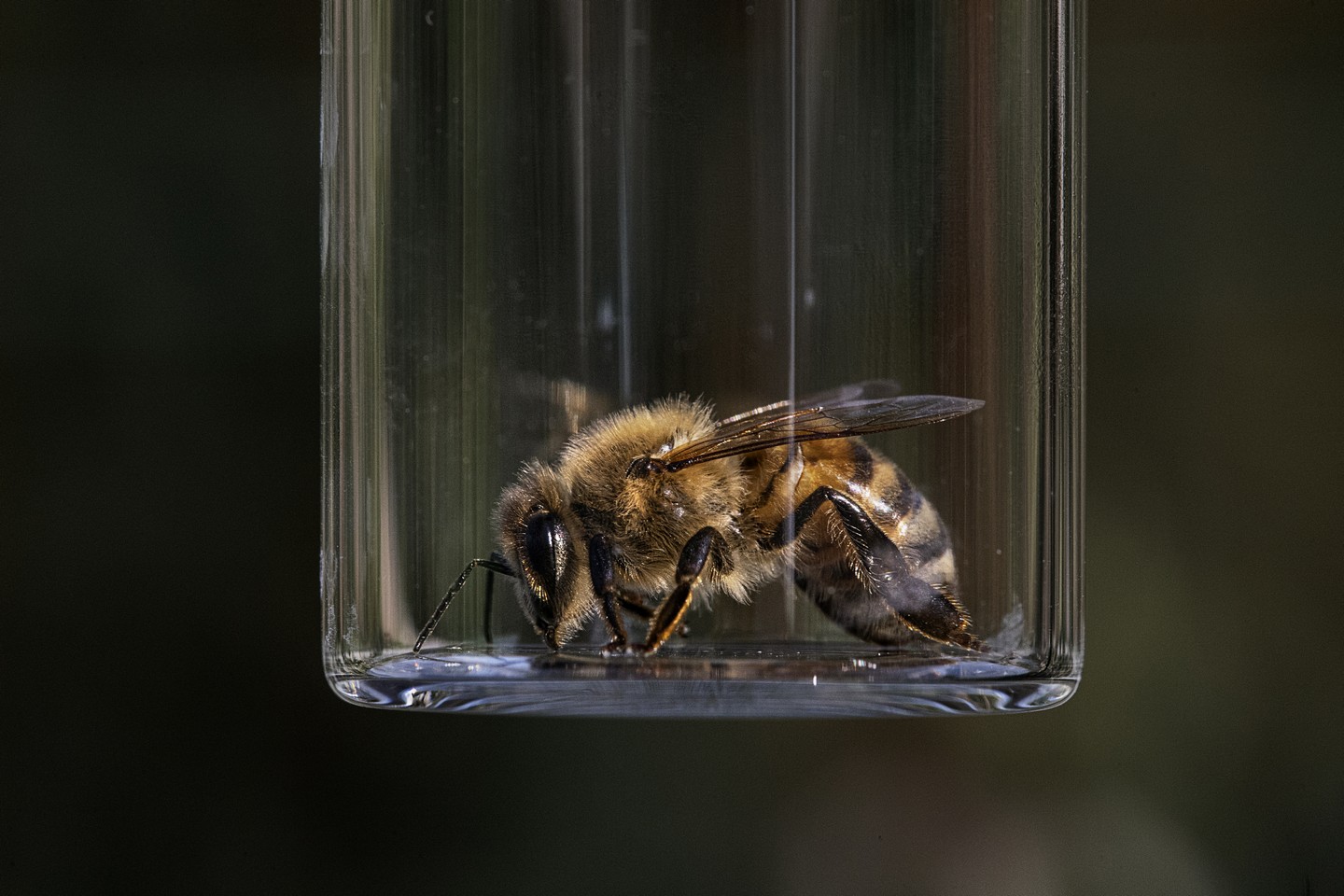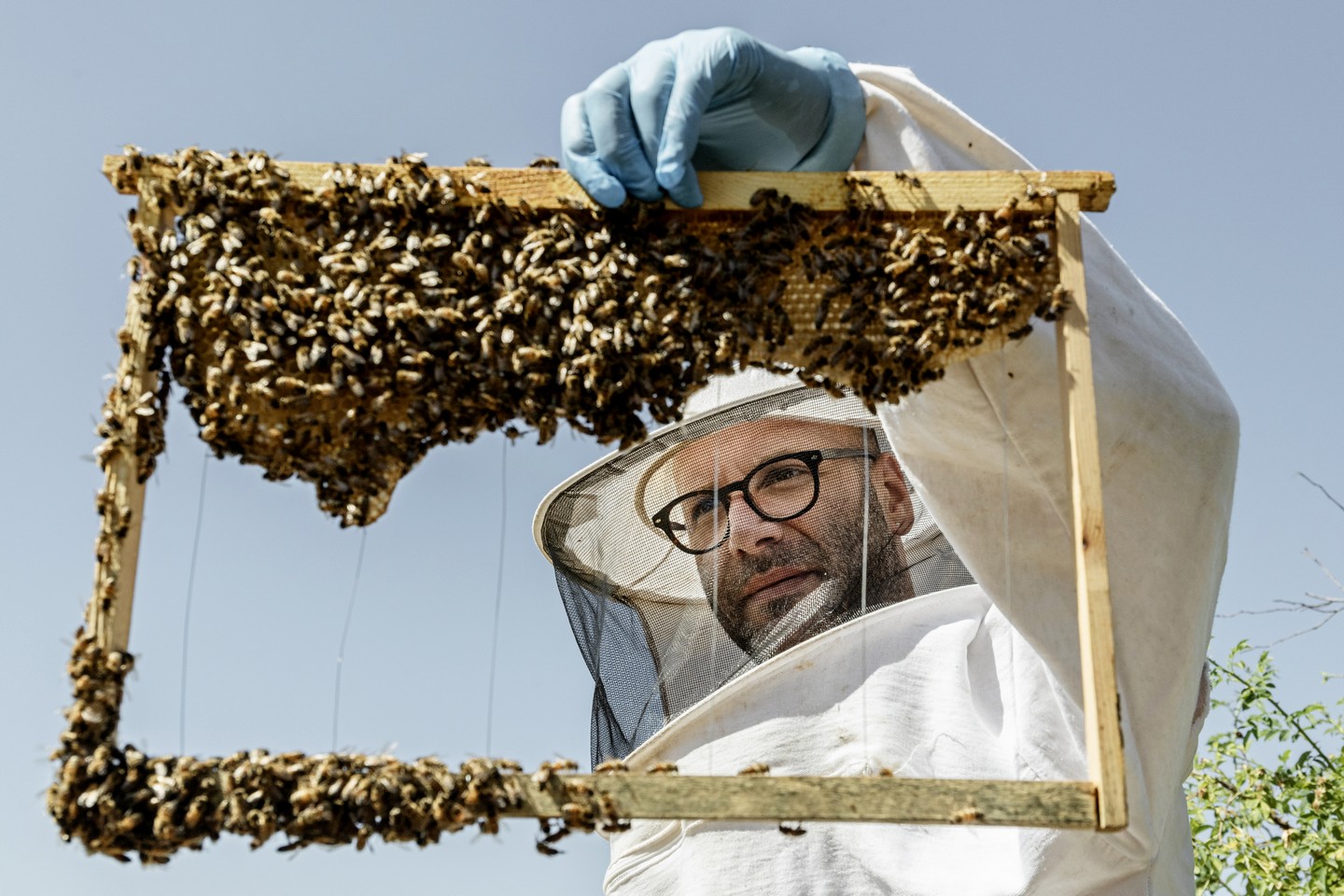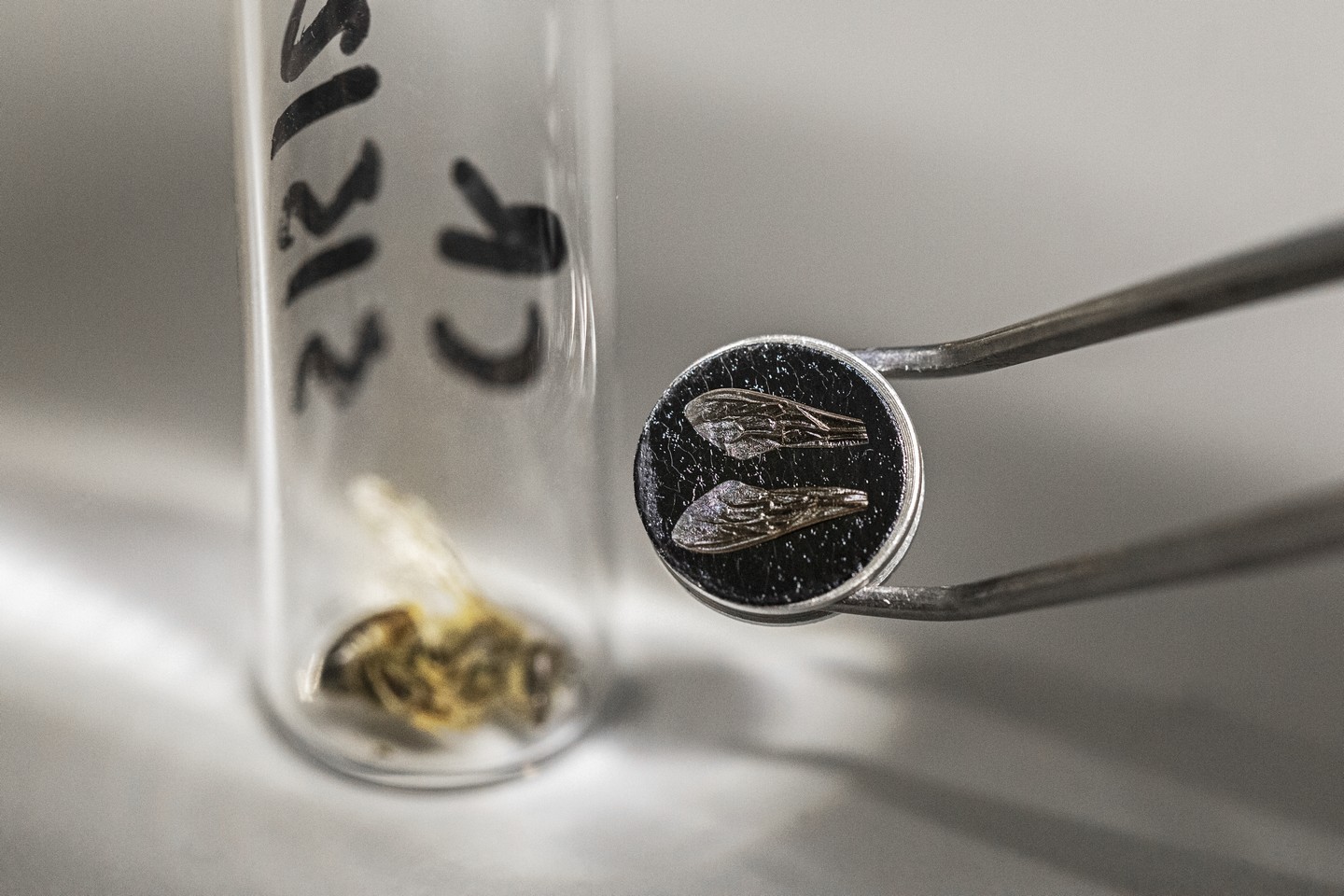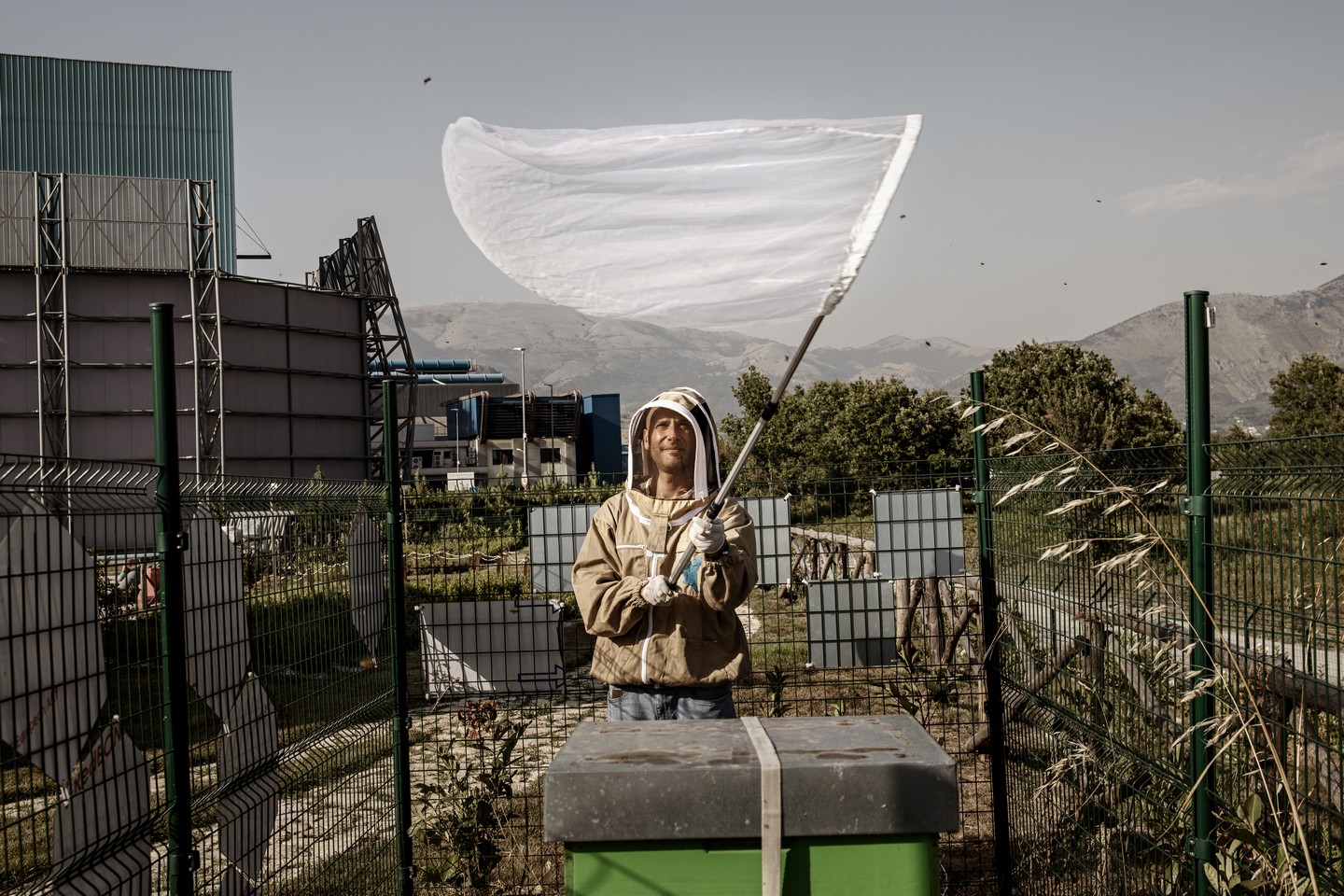Wings of Change
Text and photos by Giuseppe Nucci
Abridged by Syharn Shen (沈思含)
Wings of Change
Text and photos by Giuseppe Nucci
Abridged by Syharn Shen (沈思含)

A bee lies in a test tube for biomonitoring. The abundant pubescence on the body of the honey bee renders the insect more likely to accumulate and retain small airborne particles during flight, along with creating electrostatic-friction which enhances the attraction of such small particles to its own body. The airborne particulate deposits preferably on the bee's head, wings, and hind legs.
All the forecasts on climate change, overpopulation, ecological transition target the year 2050. By this date, and hopefully sooner, we need to remedy some unhealthy habits of the Sapiens: the first in order of importance is pollution.
First, it is good to know how conventional environmental monitoring works. Air quality detection units are instruments equipped with sensors and other observation tools, which sample the air to extrapolate punctual data on pollutants levels. There are standard thresholds, defined at the European Union and worldwide levels, for each element considered harmful or worthy of attention. Once these thresholds are trespassed, restrictive measures are taken. This is how standard monitoring of urban and industrial emissions is carried out. This is applied as well to any other pollutants emission source one might want to monitor. The air quality detection units are also called chemical-physical control units because they are able to accurately determine the nature of the elements sought, measuring their quantity and quality. These control units are highly innovative programmable machines are becoming more and more sophisticated.
Yet, are environmental control units and conventional reference measures sufficient to define and measure the environmental impact of man and its industrial production system? There is no doubt that the conventional environmental monitoring system is solid and based on universally and scientifically valid principles. But is it complete? Is it able to provide an exhaustive picture of the ecosystem to which it is applied? This is why alternative and complementary monitoring systems to those already existing are needed to better understand the environment and to better explain it to the so-called stakeholders. Bees are one such alternative and complementary monitoring system.

Founder of Urbees, Antonio Barletta has been urban beekeeping for over ten years and increasingly specializes in biomonitoring projects. Since 2020, he has been collecting samples to be analyzed and caring for the three beehives installed at the San Vittore del Lazio waste-to-energy plant, where a biomonitoring project is being carried out.
Biomonitoring uses bioindicators as storage units for data to be collected. In comparison, conventional monitoring uses mechanical samplers as data storage units. There are various types of bioindicators. They have in common the fact that they are living beings, be they animals, plants or fungi. The bioindicator must be already present in the ecosystem to be studied. The environmental quality of the ecosystem under study depends on its health and vice versa. The bioindicator changes as the conditions of the ecosystem in which it lives change and the ecosystem undergoes changes as well, as the state of health of the bioindicator changes. In other words, the bioindicator is the ecosystem litmus test. For example, the disappearance of fireflies signal environmental degradation, and the near extinction of pandas point to the deforestation of bamboo forests. Today, we have become accustomed to thinking that bees are the sentinels of the environment and that their disappearance endangers our own ecosystem.
Honey bees are insects that feed exclusively on nectar and pollen; they are so efficiently organized that can build hives with more than fifty thousand individuals. Bees survive winters thanks to a hive heating system and accumulating supplies useful for dry and cold periods. We all know bees as the queens of pollination. They are responsible for the reproduction of 80 of the 100 crops that humans eat, as well as of numerous other wild plants found on uncontaminated land. It goes without saying that bees are present in many natural and man-made environments. They have been with us for millions of years and are the guarantors of our biodiversity.

In biomonitoring, the most analyzed body parts of the bees are the wings and in particular the edge, where the particulate matter accumulates during flight. A powerful electronic scanning microscope allows observing ultra-thin powders and is equipped with an X-ray microprobe that allows analyzing the chemical composition of the particulate matter—the shape, size and composition—which are essential to identifying its origin and toxic potential.
Apis mellifera, known as the "domestic bee," is one of the most studied insects, therefore we have a large amount of useful data available. The bee has proved to be an excellent biological indicator of various contaminants in the three media (air, water and soil) where they are dispersed. Moving from flower to flower, resting on branches and leaves, ingesting water from ponds and ditches and intercepting the particles suspended in the atmosphere with its hairy body, the bee is able to provide an extremely interesting average data. In essence, they offer us the correct answer to the question of where do those pollutants that the wind or rain has blown away go. They suggest that these pollutants certainly infiltrate the food chain. And that it is also in the food chain that they must be investigated, but with alternative systems to those conventionally used today, such as honey bees.
A hive of honey bees contains an average of 50,000 bees, of which 10,000 are foragers. Each of these foragers visits around 1,000 flowers a day. Each hive carries out 10,000,000 micro-loads per day, in an area defined on the average flight range of the bees (1.5 km) equal to 7 square kilometers. Everything that bees sample in the environment is stored in a single place, the hive. This is where biomonitoring by bees is measured. There are no comparable technologies for widespread monitoring to what honey bees do. With bees, we can obtain precise and widespread information on environmental quality regarding pesticides, heavy metals, microplastics, and atmospheric particulate matter.
As the tools for monitoring environmental quality become diversified and integrated with bioindicators, we can observe the very life of social and environmental actors to understand the limits of our development and environmental sustainability. At the same time, we can safeguard the survival of bees and the biodiversity they need to feed themselves.

Antonio Barletta collecting bees by means of a net on a designated site as part of the biomonitoring activities carried out by the entomologist Ilaria Negri. The sample will be prepared and analysed at the Department of Science and Environment of the Bicocca University in Milan.
Contact Us | Plan a Visit | Donate
8 Lide Road, Beitou 11259, Taipei, Taiwan
886-2-2898-9999
005741@daaitv.com
©Tzu Chi Culture and Communication Foundation
All rights reserved.
